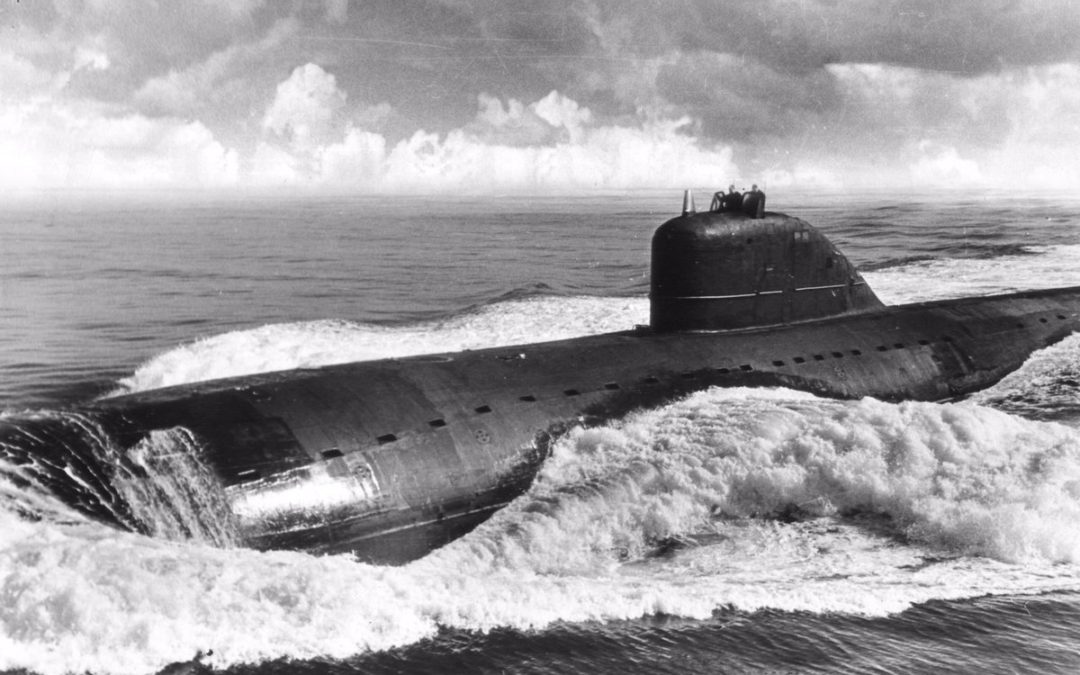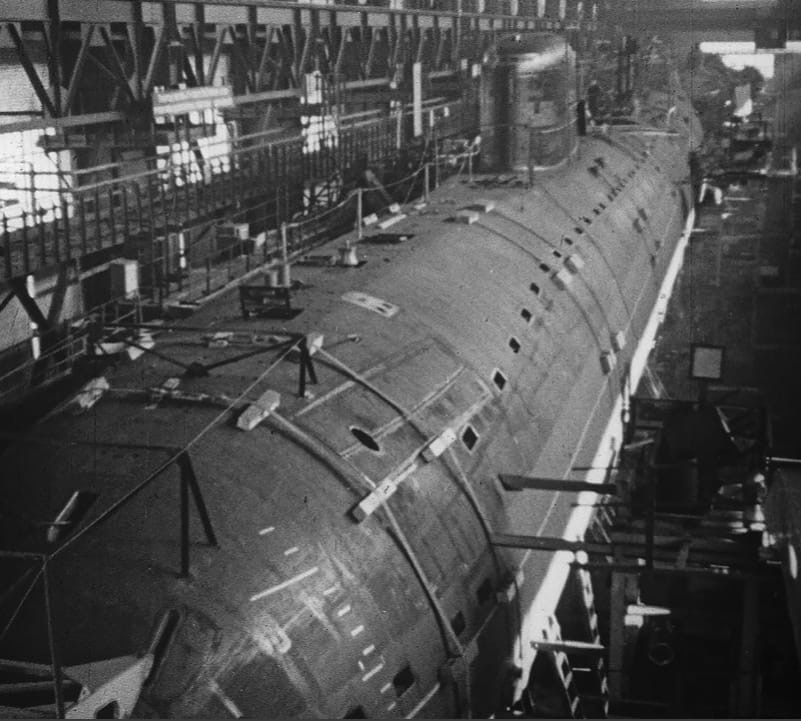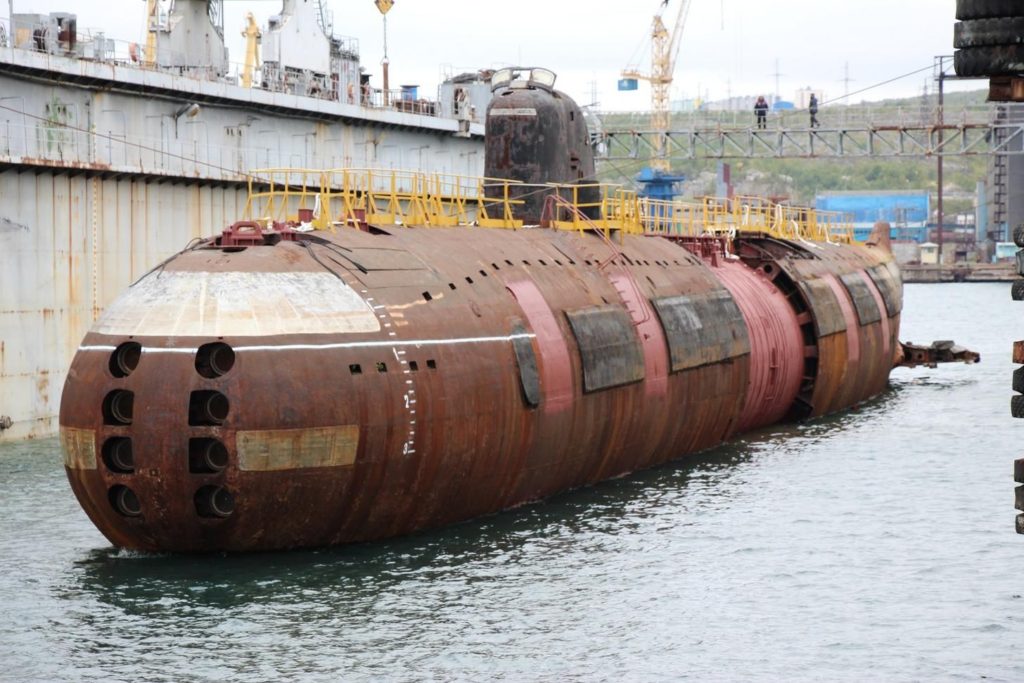In the Beginning
With the cold war reaching a new level of tension following the detonation of Jo 1 the Soviet Unions first atomic bomb, it became very clear that not only was the world going to enter into a nuclear weapons race, but also a race to build a power generation system the likes the world had never before seen.
With much testing over the years in secret laboratories across the United States, France and the UK, the final goal of creating an effectively limitless power source for a military submarine eventually came to fruition in the USA, it was led by non other than Admiral Hyman G Rickover.
On the 17th January 1955 Captain Eugene Wilkinson flashed a message that ultimately changed the world of submarines forever, it simply read “Under way on nuclear power.”
In the sea trials and exercises that followed it proved that this was almost certainly the way to go for submarines, not only can they go faster for much longer, but they can cause chaos for the current anti submarine weapons of the time.
Oddly prior to this development the Soviet government had banned any study into the possibility of developing a reactor for a submarine, fearing it would slow down the production of the atomic bomb. however, With the Nautilus now proving such a threat and the realization that Nautilus was not going to just be a one-off project the sudden realization that the Soviets needed a boat to match was realized.
The Soviet side had been watching the program with a very keen interest, and as such eventually persuaded Joseph Stalin in 1952 to build their own boat, at this moment we can say the soviets now fully understood the United states had a weapons carrier that could approach from under the Polar ice and threaten the North of Russia or any coastline at will.
It also meant their anti submarine capabilities were rendered totally ineffective, and thus the order went out catch up and overtake.
The Race is on
With the Death of Joseph Stalin in 1953 the project looked like it would be cancelled while it was still being designed. However, with Nikita Kruschev coming to power and Admiral Kuznetsov in charge of the navy the realization was that this project must continue but for a different purpose.
The T15 project which was a large torpedo designed to get into and destroy the harbors of NATO forces was scrapped, and with the scrapping of this project the project 627 was altered to become a pure attack submarine using traditional torpedoes.
Designed at SKB-143 (Malakhit) Leningrad by one of its prominent designers V.N Peregudov and the now legendry Rudy Schmarkov with the assistance of A.P Alexandrov (Kurchatov institute) for the nuclear plant, the first boat would be built at Shipyard 402 we know it as the Sevmash Shipyard Severodvinsk northern Russia.
The specifications laid out would focus on a submarine that was capable of out diving and out running surface ships and other submarines.
As a result of this, the design specification was for a submarine to be built using high tensile steel known as AK-25 as well as, two nuclear reactors but also having a hydrodynamic hull form, thus the project 627 unlike Nautilus has a cylindrical cigar shape hull form with a hydrodynamic swept back sail and a streamlined stern fin giving the 627 an edge in speed and diving depth.
Being a cigar shape the submarine is technically more hydrodynamic hence the ability to obtain 30 knots, but there is another reality to this she could also dive much deeper than other boats and the 627’s have been as deep as 340 meters, 140 meters deeper than Nautilus.
The 627’s also possessed a double hull, with the pressure hull being split into nine watertight compartments, the submarine also had a high reserve buoyancy (31% in comparison to Nautilus 16%) to ensure survivability should the boat be attacked or run aground.
The boats of the Project 627 later codenamed by NATO as the November class on paper outclassed the Nautilus substantially.
The Novembers were 107.5 meters long 8 meters wide had a draft of 5.6 meters and a submerged displacement of 4,750 tons.
Being powered by two VM-A 70mw giving a total of 140mw power or 70,000shp turning two five blade screws, they could reach speeds of 30 knots. Unlike the Nautilus single reactor and her 23 knot full speed, the 627’s were also more heavily armed using eight 533mm torpedo tubes to Nautilus six.
Like Nautilus the November was an attack submarine we call them SSN’s in the west but the Russians call them PLA (Pavodnya Lodka Atomic), this meant the main arm of the November was its eight 533mm (21in) torpedo tubes, she carried 20 reloads mainly of the 53 series of torpedoes which were designed to sink surface ships, but later used the SET-65 and USET-80 series of torpedoes to engage submarines.
Originally the Project 627 boats were planned to only carry one of the T15 torpedoes, along with two standard torpedo tubes with two 533mm torpedoes and nothing else, when the design was changed in 1953 it became clear the boat was going to be capable of carrying much more thus being more useful to the navy in the longer term, as well as being built much faster enabling the Soviet navy to put the first boat in the water in a little more than six years.
The Weapons
The redesigned Project 627 boats were built with eight 533mm (21in) torpedo tubes for standard torpedoes, It is known that the following torpedoes were the main arm of the Project 627 boats through the years:
53-51 Coming into service in 1951 the Piston engine kerosene and air mix straight running anti ship torpedo with a conventional 300kg warhead using an electro magnetic detonator. It had a top speed of 51 knots, depending on the speed of the torpedo it could run between 4 to 8 kilometers and ran at a depth between 2-14 meters.
53-57 Coming into service in 1957 a more up to date weaponcapable of 45 knots and having a range of 18 kilometres and operating between 2 and 14 meters it was powered by a piston engine using hydrogen peroxide, like the 53-51 it was a straight runner and used for anti shipping with a conventional 300kg warhead with the same electro magnetic detonator as the 53-51.
SAET-60 Came into being in 1961 and was one of the first intelligent torpedoes carrying an acoustic homing sonar and using an electrical silver and zinc battery giving it a top speed of 42 knots and a range of 13 kilometers. Again, this is a anti ship torpedo carrying a 300kg warhead.
53-61 Like the SAET-60 this torpedo was introduced in 1961, it had a warhead of 300kg and was an anti ship torpedo. It featured wake homing acoustic detection systems, However, this torpedo was powered by a turbine using Kerosene and hydrogen peroxide giving the torpedo a range of 22km and a top speed of 55 knots travelling between 2 and 14 meters below the surface.
53-65 Was a modernised 53-61 it featured an upgraded wake homing detection system as well as a more powerful turbine giving it a top speed of 70 knots, the range and diving capabilities remained the same as did the warhead.
SET-53 (M) Ultimately conceived as a anti submarine weapons the first type was a dismal failure I wasn’t until 1964 and the M model the torpedo actually gained ground. Capable of hunting other submarines it used an acoustic passive homing system, it was powered by a Silver Zinc battery giving it a top speed of 29 knots a range of 14 kilometers and a operation depth range of 20 to 200 meters. It had a conventional 100kg warhead.
SET-65 Was a marked improvement over the SET 53, operational in 1965 it had an upgraded acoustic homing sensor for passively detecting a submarine, it also had upgraded silver zinc batteries giving it a top speed of 40 knots and a range of 15 kilometers.
Operationally it also carried a larger war head a 175kg charge and was able to operate at depths from 20 to 400 meters.
USET-80 The project 627 boats are known to have carried these torpedoes but by the time the USET-80 came into service many of the project 627 had been stood down.
Entering in service in 1980 this torpedo was a multi purpose duel active and passive sensor suite which could hunt submarines or ships, it also featured a wake homing sensor and had a 300kg conventional warhead.
Powered by Silver Zinc batteries the USET-80 is designed to achieve 50 knots with a range of 20 kilometers, it can operate at depths between 2 and 500 meters.
To find out how torpedoes damage a ship click here
https://www.navygeneralboard.com/how-do-torpedoes-damage-a-ship/
The Boats and their systems
The USS Nautilus SSN 571 which was a single prototype unit, whereas the Project 627 boats were not (Although only one was originally planned in total).
The 627’s ended up as a series production with only the first boat K3 being a pure 627 design the others being a modified improved version known as project 627A and one boat K27 being so heavily modified she was known as project 645.
The first boat K3 (named Leninsky Komsomol in 1962) was laid down in June 1954, launched on 9th June 1957, Commissioned 4th June 1958 in much secrecy and would feature all the latest technology.
The November would find its targets by locating them on its MG-200 “Artika-M” Sonar which was used for target detection, and the Svet system for detecting underwater acoustic signatures.
Much Later this would be upgraded to the MG-10 Feniks in the 627A boats and the Mars -16KP Lurch Sonar systems in K3. The later we could say the Mars-16KP was a primitive MIDAS high frequency sonar for detecting mines and underwater obstacles as well as under ice navigation.
For detecting surface units the November could call upon the Nakat-M & Pluton reconnaissance electronics as well as the Prizma radar for detecting surface targets and torpedo control, although with the advanced in electronic surveillance measures the radar role was quickly redundant and thus the Nakat-M and Pluton systems were more widely used.
While its easy to see that on paper at least the November certainly does outclass the Nautilus in just about every way possible you have to factor in the reality and how these platforms operated, and its at this point when we assess the performance we realize actually the Nautilus was overall a better platform and here’s why.
The first generation of Soviet nuclear submarines were not to put too fine a point on it rush jobs, a lot of critical safety and operational items were overlooked.
The building of the boats was totally rushed, poor workmanship meant that critical systems didn’t function correctly, safety features were in some cases non existent, basic facilities broke down and this often cost the sailors who manned these vessels their lives.
Yet despite all the problems and issues series production continued with 14 boats of what was project 627 / 645, NATO November class being built in three distinct batches.
Project 627 Boat
K3
Project 627A Boats
K8, K14, K52, K21, K11, K133, K181, K115, K159, K42, K50
Project 645 Boat
K27
The K27 was heavily modified, she was 2 meters longer than her sisters, slightly narrower at 5.8 meters but critically she sported a bulbous bow which gave her a draft of 5.8 meters.
K27 would be powered differently as well, this time by two VT-1 Lead Bismuth cooled nuclear reactors which produced 73mw each giving the submarine a total of around 75,000shp in turn this gave the K27 a slightly high speed of 31 knots.
But even these modifications which made her a superior boat to her sisters would have repercussions that exist into this day.
The Mishaps
The November class like the first generation of nuclear submarines built by the Soviets were rushed, quantity not quality was the order of the day unlike the USN and UK navies which emphasized the quality factor. This ultimately played out in terms of accidents, but also they were easy to find given the soviet paid little attention to their acoustic signatures even well into their second generation boats.
I believe its fair to say that the 105 men inside the submarine came fourth place in the grand scheme of things, the first being the boats operational status, followed by the mission, the party was the next priority and finally the men.
With the quality questionable it was inevitable these boats at some point would encounter problems, and true to form they did.
On the 12th April 1970 while returning from the biggest exercise the soviet navy had ever held Okean 70 the November class submarine K8 got into difficulty in the bay of Biscay.
She spent 4 days wallowing on the surface after short circuits in the electrical systems in compartments three and seven, followed by a fire in the air conditioning unit while cruising at 120 meters under the sea.
Ultimately the commanding officer and fifty two crew died due to CO2 poisoning, and K8 eventually sank to the bottom, she wouldn’t be the last.
Fires and accidents would plague the boats throughout their lives, the project 645 boat K27 had a reactor incident where the AR-1 control rod withdrew from the reactor un-commanded, ultimately this lead to a power decrease and a release of radiation.
In all 124 men were irradiated heavily and 4 of the men died as a result. Since this accident in 1967 over 30 of the crew have since died.
K27 was laid up in 1968 and used for experimental works until 1973 when she was assessed for repair, it proved too costly, and in 1981 the reactor compartment was filled with a solidifying mixture of furfurol and bitumen, the K27 was then towed to the Kara sea and scuttled on September 6th 1982.
K27’s saga does not end there because, she was scuttled in water only 33 meters deep in direct contravention of IAEA requirements.
The International Atomic Energy Association (IAEA) state the water must be at least 3,000 meters deep which was recognised by the now Russian federation in 2012, since then a workable plan has been in the pipeline to raise K27 and scrap her safely.
The November boats had a notorious bad luck streak even after they were decommissioned, they would still take lives. Just two years after the loss of the K141 Kursk the K159 on her way to the scrap yard sank with the loss of 9 men.
Despite the bad reputation and poor quality the boats themselves all served in the Soviet navy well for extended periods of time in most cases more than 25 years in service was achieved.
The last of the class K14 was decommissioned in 1990 putting an end to the first generation of boats and only one year from the collapse of the Soviet Union.
Today the only survivor of the class is the K3, she is currently undergoing restoration in Murmansk to become a museum submarine in St Petersburg.
Other Articles Available
Project 611 Zulu class submarines: https://www.navygeneralboard.com/project-611-zulu-class-submarines/
Walk through of a Foxtrot class Submarine:
https://www.navygeneralboard.com/a-cold-war-warrior-a-walkthrough-of-a-foxtrot-class-submarine/








Recent Comments